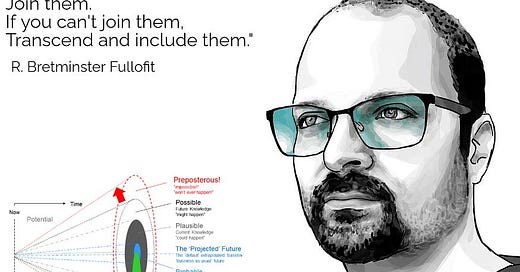Omnicentralization
If you can't beat them, join them. If you can't join them, transcend & include them
Whereas centralization might refer to a single authority of power, management and decision-making, decentralization generally means several sources (or more) of authority.
In our instance here, ‘Omnicentralization,’ would refer to every part of a whole being an authority of power.
In this sense, omnicentralized architectures are very similar to decentralized architectures, where authority is delegated throughout.
Nonetheless, decentralization and centralization are really two sides of the same coin, and there are times and places where each of those ‘sides’ are more or less beneficial. Neither side is universally ‘true’ nor absolutely appropriate in a given circumstance.
Furthermore, decentralization can be often understood to be ‘the process of dispersing power away from a central authority’ compared to omnicentralization which would be understood as a sharing of power among an unlimited set of central authorities. This nuance is key.
In the process of ‘transcending and including’ we are looking to go beyond the polarization and often reactionary stance of centralized versus decentralized, and to preserve the best of each option in a more transcendent model of Omnicentralization, where creative authority is honored and each person is a central point of power sharing that power with others.
Omni- means “all” … An omnicentralized system or reality would refer to a circumstance where ‘all and therefore each’ part of the whole is both a single point of authority whilst also being one of many single points of authority. The ‘trick’ is to distribute power, control, and decision-making among the single points of authority in ways which both serve the whole and each singular point. An omnicentralized system or reality could therefore be described as composed of harmonious interdependent parts that maintain various vital processes of the whole.
The equality of an omnicentralized system relies on the uniqueness of each single authority and its ability to be in harmony with the whole as it pursues its own destiny within that knowing; somewhat akin to the beautiful naming of David Spangler on his view of Holarchy:
David Spangler uses the term “Holarchy” in a different meaning: “In a hierarchy, participants can be compared and evaluated on the basis of position, rank, relative power, seniority, and the like. But in a holarchy each person’s value comes from his or her individuality and uniqueness and the capacity to engage and interact with others to make the fruits of that uniqueness available.”
An omnicentralized system therefore requires a level of awareness related to deep ecological, spiritual and physics related insights. From this awareness, it is possible to both be a single source of authority with a unique destiny and also be part of a greater whole which harmonizes these sources together, which can sing from the same song sheet.
One way to live through and create omnicentralization is to understand omnicentric mind as expressed below by philosopher and visionary Yasuhiko Kimura. Through mutual understanding and personal freedom from our own assumptions and paradigms, it is possible to share power and authority among people while simultaneously remaining unique singular points of authority. There’s no need to diffuse or disperse power, authority and decision-making; these activities can be shared, distributed and entrusted through the qualities of omnicentric mind and the practice of omnicentralization.
When there is no center — every point of authority is a center. This is the beauty, paradox and wonder of omnicentricity. This is how we will transcend and include centralization and decentralization into the bold frontier of omnicentralization.






said structures of spacetime membering the geometrees of the cosmic forest of life also embody at least a fourth kind of polyness, which is polyintegrity. as there are at least four kinds of integrities present within and around everybody, yet not necessarily equally minded, if at all, by the babylonian booxes.
integritee of the whole, that is Universe as within, without and witharound
integritree of tension aka tensegritree
integritree of pattern
integritree of the individual
and as with all things spherical, the wholeness of Universe is an aggregate, so these principles at play remain omnitriangulated, omniinteraccomodative and open for additional consideration, constellation and contemplation
i love that thought, omnicentralization as another synonym for compendence, or as i lovingly call it, compendance. i have been speaking of polycentricity as another aspect of spherical thinking in synergetics where it turns out the structures of spacetime are always polyoptic (manyeyed), polyform (manyformed in the complementarity of the Whole) and polycentric, which speaks to the ability of fluidly changing ones focus of tuning from hearts (notes, vortexes where things happen, interweave, nest, also centers of gravity of subsystems as organs within organisms) to fingers (the verbial vectors of relationship pointing bothways between the hearts, each with their own center of gravity) to the eyes they open among them as the triangles membering membranes of mindful matter, animatter, spreading gravity around oneandother, fathomable belonging together, compending, compassionately, again synergizing our shared center as a fractal of the whole that is Universe...